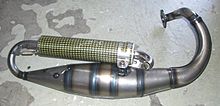Resonance exhaust
A resonance exhaust is an exhaust system of internal combustion engines that is used particularly to optimize the performance of two-stroke engines. Walter Kaaden dealt with this in the MZ racing department . He found out that the use of resonance waves of the exhaust tract leads to a significant increase in performance and developed the resonance exhaust, which is used in racing and model sports as well as in road vehicles.
This exhaust basically consists of six parts: the elbow , a mostly curved pipe with a constant diameter, which is connected to the outlet of the cylinder , an opening cone (the so-called diffuser), a cylindrical center piece, a closing counter-cone (reflector), the pressure pipe, a pipe of constant diameter and a certain length, to which the last part of the resonance exhaust, the silencer , is connected.
Its basic function is to delay the reflection of the exhaust gas pressure wave (the so-called "puff"), which presses into the exhaust when the exhaust port is opened, at the counter cone. The diffuser creates a negative pressure gradient between the cylinder and the beginning of the cone, which creates a suction effect at the outlet that conveys the exhaust gas out of the cylinder. The part of the pressure wave reflected by the counter-cone at the rear swings back to the exhaust port over the length of the exhaust pipe and pushes any fresh gas that may have escaped into the exhaust back into the cylinder, whereby the cylinder is also "charged" with mixture from the exhaust side. will (see animation). Optimum cylinder filling is achieved at what is known as the resonance speed.
See also
- noise
- noise protection
- Road traffic noise
- Engine charging # Resonance charging in the intake system
literature
- Max Bohner, Richard Fischer, Rolf Gscheidle: Expertise in automotive technology. 27th edition, Verlag Europa-Lehrmittel, Haan-Gruiten, 2001, ISBN 3-8085-2067-1
- Hans-Hermann Braess, Ulrich Seiffert: Vieweg manual automotive technology. 2nd edition, Friedrich Vieweg & Sohn Verlagsgesellschaft mbH, Braunschweig / Wiesbaden, 2001, ISBN 3-528-13114-4
- Peter A. Wellers, Hermann Strobel, Erich Auch-Schwelk: Vehicle technology expertise. 5th edition, Holland + Josenhans Verlag, Stuttgart, 1997, ISBN 3-7782-3520-6

